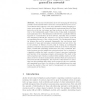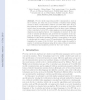130 search results - page 16 / 26 » Language networks: Their structure, function, and evolution |
HASKELL
2005
ACM
14 years 1 months ago
2005
ACM
Haskell has proved itself to be a suitable implementation language for large software projects. Nevertheless, surprisingly few graphical end-user applications have been written in...
WAC
2004
Springer
14 years 27 days ago
2004
Springer
The amount of information in the new emerging all-embracing pervasive environments will be enormous. Current Internet protocol conceived almost forty years ago, were never planned ...
BMCBI
2008
2008
WSPMaker: a web tool for calculating selection pressure in proteins and domains using window-sliding
13 years 7 months ago
Background: In the study of adaptive evolution, it is important to detect the protein coding sites where natural selection is acting. In general, the ratio of the rate of non-syno...
IFM
2010
Springer
13 years 6 months ago
2010
Springer
Process calculi supporting mobile communication, such as the π-calculus, are often seen as an evolution of classical value-passing calculi, in which communication between processe...
TCS
2008
13 years 7 months ago
2008
A notation for the functional specification of a wide range of neural networks consisting of temporal or non-temporal neurons, is proposed. The notation is primarily a mathematica...


